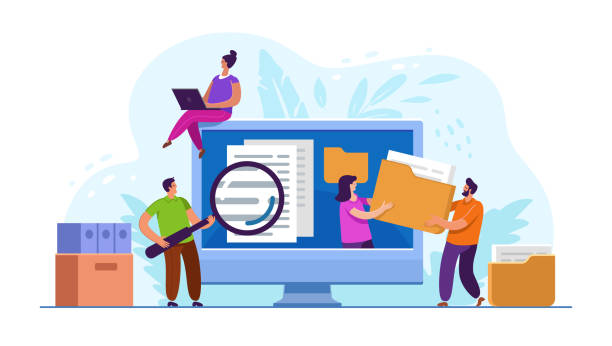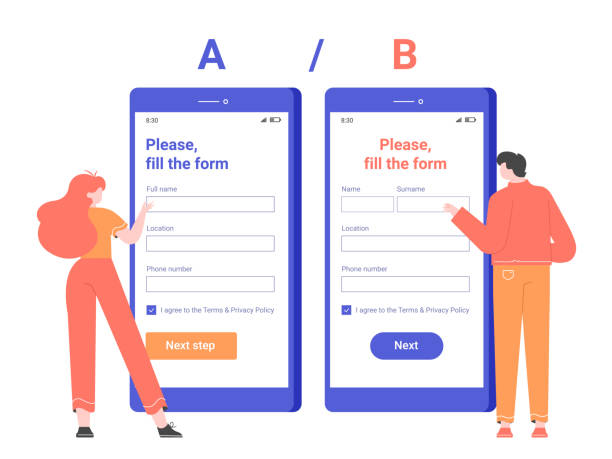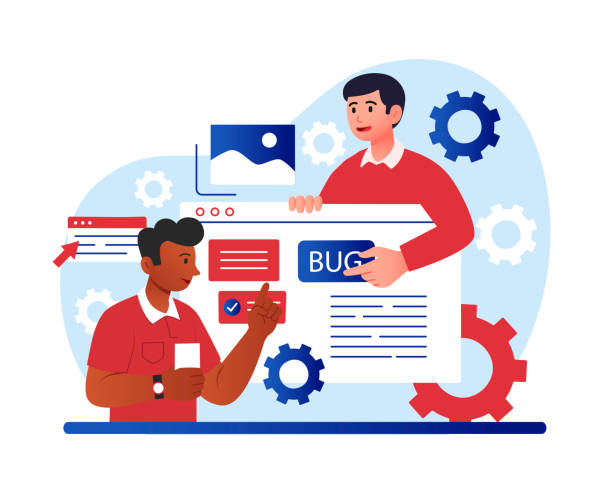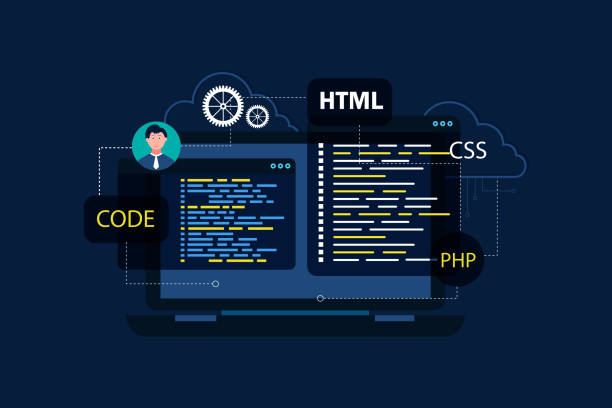The Importance of Secure Website Design in Today’s Digital World
![]()
In the current era, where the internet has become the backbone of businesses, #secure_website_design is no longer an option but an indispensable necessity.
Websites are not only the showcase of your business but also a place for interacting with customers, collecting sensitive information, and conducting financial transactions.
An insecure website can lead to customer data loss, privacy breaches, damage to brand reputation, and even heavy legal penalties.
A security breach can result in a loss of customer trust, which is very difficult to regain.
Imagine your online store’s website being attacked and customers’ credit card information stolen; this incident could inflict irreparable damage on your business.
Therefore, emphasizing secure website design from the very initial stages of development is crucial.
This proactive approach significantly reduces potential costs resulting from cyberattacks and ensures the security of your users’ and business’s information.
Understanding the existing risks and taking necessary measures to protect the website against cyber threats is considered a fundamental principle of cybersecurity and is essential for every business owner seeking stability and growth in the online space.
Are your e-commerce site visitors leaving before making a purchase? Don’t worry anymore! With Rasaweb’s professional e-commerce website design services, solve the problem of not converting visitors into customers forever!
✅ Significant increase in conversion rates and sales
✅ Unique and engaging user experience
⚡ Contact us now for a free consultation!
Identifying and Countering Common Web Vulnerabilities

To achieve a secure website design, a deep understanding of common website vulnerabilities is of high importance.
#web_vulnerabilities like #SQL_Injection, #Cross_Site_Scripting_(XSS), and #Cross_Site_Request_Forgery_(CSRF) can all be gateways for attackers.
SQL Injection allows an attacker to gain access to the database, modify, or delete information by injecting malicious SQL code.
XSS enables an attacker to inject client-side script code into web pages and gain access to sensitive user information.
CSRF also allows an attacker to perform unwanted actions on behalf of authenticated users.
Being #educational in this field helps you identify these weaknesses and take action to fix them.
To counter SQL Injection, the use of Prepared Statements and parameterizing queries is essential.
For XSS, user inputs must be validated and outputs correctly encoded.
Countering CSRF is also possible by using anti-CSRF tokens.
These measures are part of the OWASP Top 10 guidelines, which are a trusted reference for identifying and fixing web security vulnerabilities.
Implementing these actions will be a fundamental step towards increasing the stability and security of your website and paves the way for secure website design.
Secure Coding Principles and Best Practices

Secure website design begins from its fundamental coding.
#secure_coding not only means preventing external attacks but also involves designing a system that is resilient against internal errors.
The #most_specialized approach in this regard is adherence to best practices.
Input validation, is the first line of defense; any data received from the user must be carefully checked to ensure it matches the expected format and does not contain malicious code.
Output encoding is also vital for preventing XSS attacks, meaning that any data displayed to the user must be converted into a safe format.
Using reputable security frameworks that benefit from built-in security features such as protection against CSRF and XSS can greatly help enhance security.
Additionally, proper error handling and detailed logging of security events help identify and track intrusion attempts.
These logs are essential for precise #analysis and continuous security improvement.
Ultimately, secure website design requires a comprehensive approach to coding that not only addresses known vulnerabilities but also builds resilience against emerging threats.
The table below summarizes best practices in secure coding:
| Security Action | Description | Purpose |
|---|---|---|
| Input Validation | Carefully checking all data received from users to prevent malicious code. | Prevention of SQL Injection, XSS, and Command Injection. |
| Output Encoding | Converting special characters in outputs displayed to users. | Prevention of Cross-Site Scripting (XSS). |
| Using Parameterized Queries | Separating data from SQL commands when building database queries. | Prevention of SQL Injection. |
| Secure Error Handling and Logging | Providing generic error messages and recording detailed error information in secure logs. | Preventing the disclosure of sensitive information and aiding in attack tracing. |
| Using Secure Frameworks | Leveraging frameworks and libraries that have built-in security features. | Reducing the developer’s security burden and utilizing tested solutions. |
Database Security: A Vital Role in Information Protection

The database is the heart of every website and contains the most valuable information, including user data and sensitive business information.
Therefore, #database_security is an indispensable component of secure website design.
The first step in securing the database is to use strong and unique passwords for all database user accounts.
Furthermore, the Principle of Least Privilege must be observed; meaning that each user or application should only be granted the minimum necessary access to perform their tasks.
Encrypting sensitive data, both in transit and at rest, is of high importance.
This prevents unauthorized access to information even if the system is breached.
Regular and tested database backups are also crucial to ensure full recovery in case of an incident or data loss.
The #most_specialized solutions include continuous monitoring of database activities to identify suspicious patterns and using Database Firewalls to filter malicious traffic.
Do not forget that database security is an ongoing process and must be periodically reviewed and updated to keep pace with new threats.
Does your company website create a professional and lasting first impression in the minds of potential customers? Rasaweb, with its professional corporate website design, not only represents your brand’s credibility but also opens a path for your business growth.
✅ Creation of a powerful and trustworthy brand image
✅ Attracting target customers and increasing sales
⚡ Get a free consultation now
Server and Network Hardening: The Foundation of Web Security

A website, even with secure coding, will be vulnerable if hosted on an insecure server and network.
#server_hardening and #network_security form the foundation of secure website design.
A precise #analysis of infrastructures shows that proper server configuration, regular application of operating system security patches, and software used are the first steps.
Removing unnecessary services from servers leads to a reduction in the attack surface.
Configuring firewalls, both software and hardware, is vital for controlling inbound and outbound traffic and blocking unnecessary ports.
The use of Intrusion Detection and Prevention Systems (IDS/IPS) helps identify and block suspicious activities in real-time.
Protection against DDoS (Distributed Denial of Service) attacks is also of high importance, as these attacks can take your website offline.
This includes using specialized DDoS Protection services and optimizing network infrastructure to manage high traffic.
The more security layers implemented at the server and network level, the greater the website’s resistance to cyber threats.
User Authentication and Access Management

One of the most important aspects of secure website design is #user_authentication and #access_management.
Strong authentication systems are the first line of defense against unauthorized access.
Enforcing the use of complex and unique passwords, and encouraging users to activate Two-Factor Authentication (MFA), significantly increases the security of user accounts.
MFA provides an additional layer of security, and even if a password is leaked, an attacker cannot access the account.
Proper Session Management is also vital; sessions must have an expiration time and be invalidated after user logout or inactivity.
To enhance security, session tokens should be randomly generated and transmitted only through secure protocols (such as HTTPS).
Practical #guidance in this area includes implementing Role-Based Access Control (RBAC), so that each user has access only to the resources and functionalities defined for their role.
This approach prevents unauthorized Privilege Escalation.
Also, strong encryption of passwords (using secure hashing functions like bcrypt) before storing them in the database, is of high importance.
Security Audits and Continuous Updates

A secure website design is not achieved with a one-time implementation; it is a continuous process that requires #security_audits and #continuous_updates.
The #good_news is that many tools are available to assist with this process.
Regular vulnerability scans and Penetration Testing, are crucial parts of these audits.
Vulnerability scans automatically identify known weaknesses, while penetration testing is performed by security specialists to find more complex and logical vulnerabilities.
These processes help you identify and fix weaknesses before attackers discover them.
Furthermore, keeping the server operating system, web frameworks, libraries, and all used software up-to-date, is of high importance.
Developers constantly release security patches to address discovered vulnerabilities, and failing to apply these updates can put your website at risk.
Awareness of new security threats (Threat Intelligence) and recent events in the cybersecurity world also helps you act proactively.
This is a #guidance approach for maintaining long-term website security and stability.
The table below illustrates the planning for security audits and updates:
| Activity | Recommended Frequency | Purpose |
|---|---|---|
| Automated Vulnerability Scan | Monthly or Quarterly | Quick identification of known vulnerabilities in code and infrastructure. |
| Penetration Testing | Annually or after major changes | Discovery of complex and logical vulnerabilities by specialists. |
| Applying Operating System Security Patches | Immediately after release | Addressing security loopholes at the server operating system level. |
| Updating Frameworks and Libraries | Immediately after security updates are released | Protection against vulnerabilities present in software components. |
| Reviewing Security Logs | Daily or Weekly | Identification of suspicious activities and intrusion attempts. |
Planning for Incident Response and Data Recovery

Even with the best secure website design approaches, the probability of a security incident is never zero.
It is important to plan for these events.
Having a #Incident_Response_Plan (IRP) comprehensive and efficient, is crucial.
This plan should include specific steps for identification, containment, eradication, recovery, and lessons learned.
Training the team to execute this program is also of particular importance.
The #most_specialized part of this plan, is the Disaster Recovery strategy, which includes regular and tested backups of all website data and configurations.
These backups should be stored in a secure location separate from the main server so that data can be recovered if lost.
You should also have the ability to quickly rebuild the website environment in case of severe attacks or system failures.
Transparency in notifying users in the event of a security breach (within the framework of relevant laws) also helps maintain trust.
A strong incident response plan not only minimizes damages but also helps you learn from negative experiences and continuously improve your website’s security.
Are you dissatisfied with your e-commerce site’s low sales?
Rasaweb is your solution for having a professional and high-selling e-commerce website.
✅ Significant increase in sales and revenue
✅ Easy and enjoyable shopping experience for customers
⚡ Get a free consultation from Rasaweb now!
Legal and Ethical Aspects of Website Security

Beyond technical aspects, #secure_website_design is also intertwined with a set of #legal and #ethical_aspects.
With increasing public awareness and the enactment of stricter data privacy laws, such as GDPR (General Data Protection Regulation) in Europe and similar laws in other countries, businesses are obligated to adhere to specific standards in collecting, processing, and storing user data.
Non-compliance with these regulations can lead to very heavy fines and loss of credibility.
The #questionable_content in this context is how we can strike a balance between providing a smooth and engaging user experience and maximizing adherence to security and privacy principles.
This is an ongoing challenge that requires creative solutions.
In addition to laws, ethical considerations also play a significant role.
Accountability for protecting user data, transparency regarding data usage, and respect for individual privacy are fundamental ethical principles in the digital world.
Adherence to these principles not only helps maintain business credibility but also leads to the creation of a safer and more trustworthy digital ecosystem.
The Future of Secure Website Design and Upcoming Innovations

The world of cybersecurity is a constant battleground where attackers and defenders are continuously evolving.
The #future_of_secure_website_design will also be influenced by technological innovations and the emergence of new threats.
A precise #analysis shows that Artificial Intelligence and Machine Learning (AI/ML) will play an increasing role in detecting and preventing complex attacks.
On the other hand, attackers may also use these technologies to develop smarter attacks.
Blockchain technology may also be used in the future to strengthen data security and decentralized authentication.
With the growth of the Internet of Things (IoT) and the increasing number of connected devices, the attack surface will also expand, and the need for secure website design solutions that can cover this broad ecosystem is felt more than ever.
Hence, the Security by Design approach becomes a fundamental principle.
For businesses seeking stability and growth in the digital space, investing in continuous training for technical teams and using expert security consultants to keep pace with the latest advancements and threats, is crucial.
This is an #entertaining yet challenging process that requires agility and a long-term vision.
Frequently Asked Questions
| Row | Question | Answer |
|---|---|---|
| 1 | What is secure website design? | The process of designing and developing websites that are resistant to cyberattacks and protect user data and privacy. |
| 2 | Why is website security important? | To prevent data breaches, financial losses, damage to company reputation, and maintain user trust. |
| 3 | What are some common website security threats? | SQL Injection, XSS (Cross-Site Scripting), CSRF (Cross-Site Request Forgery), weak authentication, and unpatched software. |
| 4 | What is SSL/TLS and what role does it play? | Protocols for encrypting data between the user’s browser and the website server, ensuring secure and private communication. |
| 5 | How can SQL Injection attacks be prevented? | By using Prepared Statements/Parameterized Queries, input validation, and ORMs (Object-Relational Mappers). |
| 6 | What is the role of a Web Application Firewall (WAF) in security? | A WAF monitors and filters HTTP traffic between a web application and the internet to prevent malicious attacks. |
| 7 | Why are regular software and library updates necessary? | Updates include patches for known security vulnerabilities that attackers can exploit. |
| 8 | How can XSS attacks be prevented? | By sanitizing and escaping all user inputs before displaying them on the web page and using Content Security Policy (CSP). |
| 9 | What does the Principle of Least Privilege mean? | It means that users and systems are given only the minimum necessary permissions to perform their tasks to prevent unnecessary access to resources. |
| 10 | What is the importance of proper user session management? | To prevent session hijacking and unauthorized access to user accounts through secure and expiring session tokens. |
And other services of Rasaweb Advertising Agency in the field of advertising
Smart Marketing Automation: A novel service to improve SEO ranking through key page optimization.
Smart Digital Advertising: An effective tool for campaign management with the help of key page optimization.
Smart UI/UX: A new service to enhance campaign management through custom programming.
Smart Customer Journey Map: Revolutionize sales growth with precise audience targeting.
Smart Custom Software: A fast and efficient solution for user interaction with a focus on marketing automation.
And over a hundred other services in the field of online advertising, advertising consulting, and organizational solutions
Online Advertising | Advertising Strategy | Advertorials
Resources
Secure Website Design Tips
Website Security Guide
Website Security Checklist
Online Business Security
? To elevate your business in the digital world, Rasaweb Afarin Digital Marketing Agency offers comprehensive services including professional website design, SEO optimization, and social media management, paving your path to growth and success.
📍 Tehran, Mirdamad Street, next to Bank Markazi, Southern Kazeroon Alley, Ramin Alley No. 6



